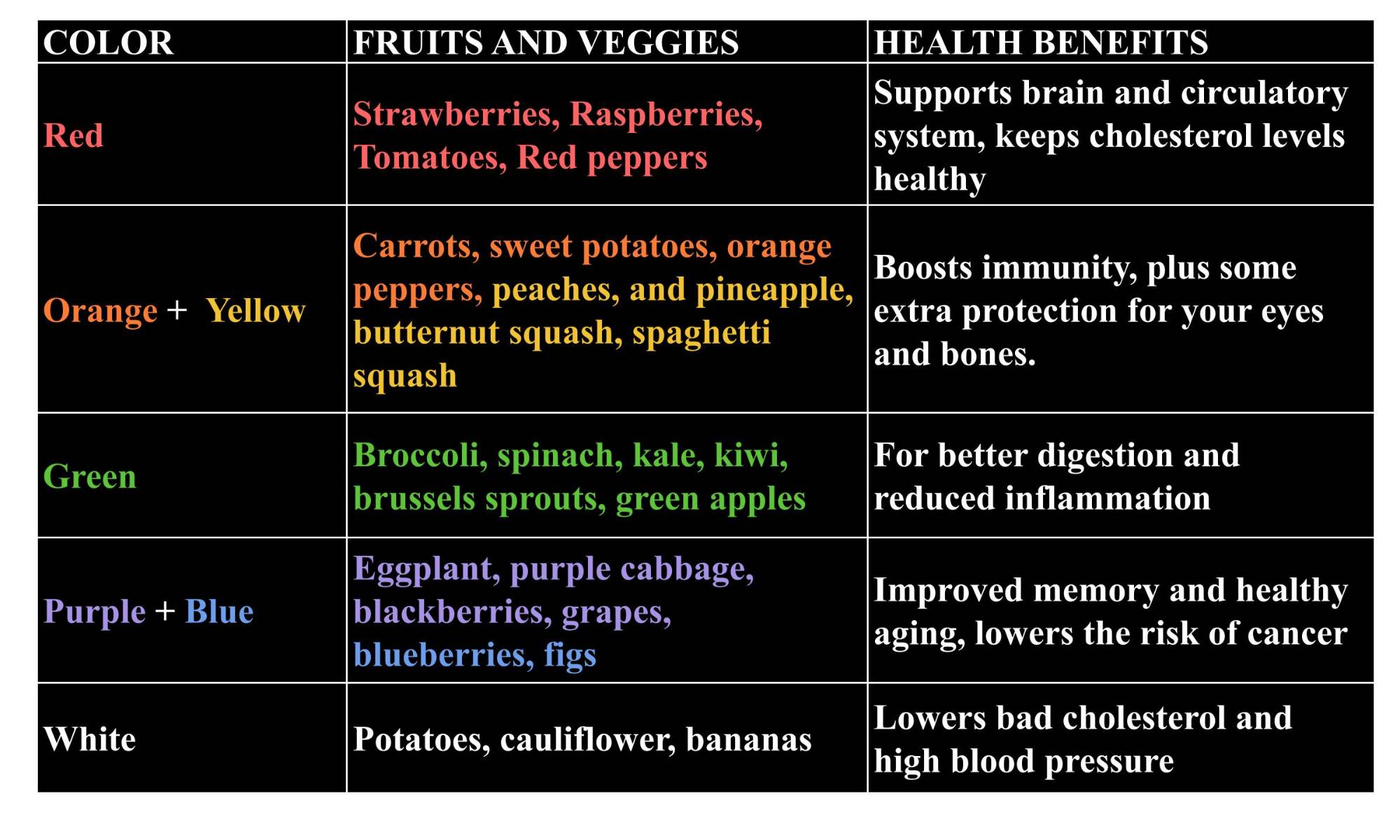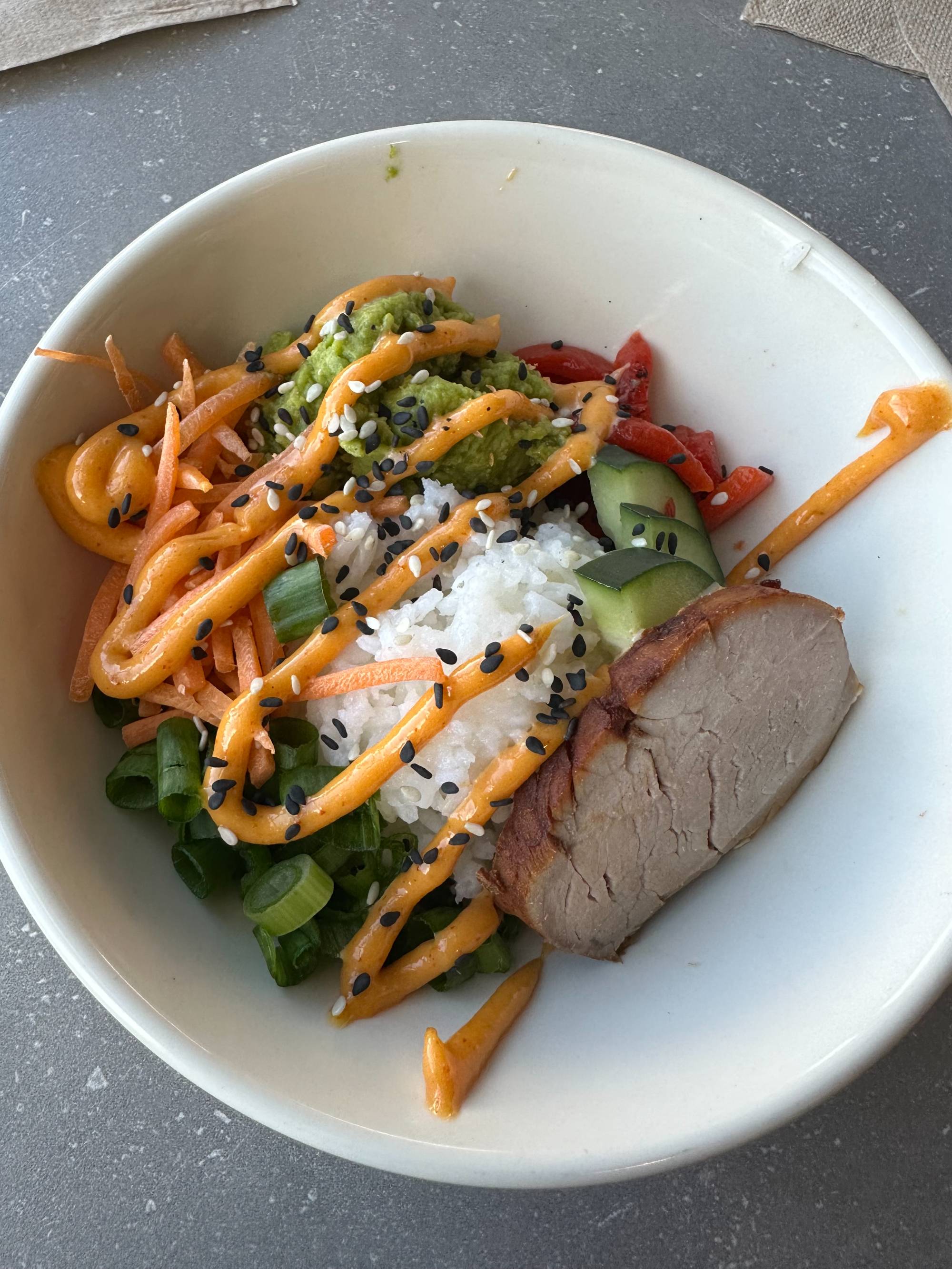Blog
Permanent link for Color Challenge for GV Students! How Colorful is Your Plate? on April 25, 2024
What color is your food on your daily plate? Does it have lots of colors, like the rainbow? Whether your answer is “yes”, you have lots of colors, or “no”, it is all the same, it is okay because, in this blog post, we will go through the widely heard term “eat the rainbow”.
Why is Color Important?
Each color of food contains different plant compounds and corresponding nutrients, offering its health benefits. Let’s look at the colors and benefits of fruits and vegetables.
Red: Strawberries, Raspberries, Tomatoes, Red peppers - Supports brain and circulatory system, keeps cholesterol levels healthy.
Orange + Yellow: Carrots, sweet potatoes, orange peppers, peaches, pineapple, butternut squash, spaghetti squash - Boosts immunity, plus some extra protection for your eyes and bones.
Green: Broccoli, spinach, kale, kiwi, brussels sprouts, green apples - For better digestion and reduced inflammation.
Purple + Blue: Eggplant, purple cabbage, blackberries, grapes, blueberries, figs - Improved memory and healthy aging, lowers the risk of cancer.
White: Potatoes, cauliflower, bananas - Lowers bad cholesterol and high blood pressure.
Eat the Rainbow on Campus
Some of us might already have this head knowledge but don’t know how to practically do it. It may seem like on campus there are limited options, but sometimes it just takes a little more intention to have a colorful plate. If you are looking for colorful food on campus, here are a few suggestions:
- At Fresh Food Co. and the Dish, you can get a variety of colorful food options as they have a salad bar, Entrée, Fire and Ice (omelette bar in the morning, Pasta or Stir fry bar in the afternoon), and One World Kitchen. If you are allergic to certain kinds of food, they have My Fresh Pantry at Fresh Food Co. and True Balance inside the Dish.
- At P.O.D. If you're looking for a quick and refreshing option, Naked juices are a great choice! They contain natural sugars and offer the goodness of real fruits, making them a wholesome pick when you need something on the go.
- If you are looking for Asian-style food, you can try Bento near the Laker store where they have different kinds of bowls with protein, mixed salad, and rice, allowing you to have a diverse mix of colorful food.
- If you are looking for more interesting options, you can try Panda Express which is in Kirkhof. They have Kung Pao chicken, broccoli beef, and so on.
- Fresh fruits like Bananas, Apples, and Oranges are always available at P.O.D., Fresh Food Co., and The Dish. Quick and easy to grab.
- If you ever see a WIT Cart, feel free to grab a healthy snack like Trail mix and Popcorn.
- For more options on campus, you can visit https://www.gvsu.edu/campusdine
Looking for off-Campus Options?
Teatime Café, the Borough and the 616 Kabob Stop Express are great choices.
- Teatime Café (if you are unsure how to get there, you can take the Rapid bus 37, 48, or 85 during weekends) - https://www.teatimecafe.net/menus , you can try their different kinds of poke bowls or bento boxes (yummy!)
- The Borough (You can take a Rapid bus 48 or 85 or take an 8-minute walk from campus :) - https://theborough.co/menu/ , they have some great Açai bowls, smoothies, paninis, and more.
- The 616 Kabob Stop Express (You can take a Rapid bus 48 or 85)- https://www.616kabobstopexpress.com/
Fruits and Veggies, the Ins and Outs
- Some fruits and vegetables, like avocados and bananas,a can provide more energy than others. It can be helpful to keep this in mind so you can tailor your meals to your personal goals.
- If fresh fruits and vegetables aren't available, frozen options are just as healthy (for example, to make a smoothie) and can be more convenient for a student's lifestyle.
- Canned fruits and vegetables can be nutritious. Make sure to look for low-sodium options and avoid options that have high amounts of added sugars.
- Dried fruits can have many nutrients, including fiber. Look for options that have zero or low added sugars.
- Some vegetables are more starchy than others, so it’s important to include a variety of different types in your diet. For example, if you are having potatoes and corn, try to add in a vegetable like broccoli or snap peas that do not have as much starch. Eating different colors of vegetables can help with this!
With so many colorful fruits and vegetables, you can create a colorful diet that is healthy, delicious, and nutritious. There are more than enough options on and off campus, it just takes a little mindfulness to create a rainbow diet.
By: Priyan, WIT Peer Educator
Resources:
https://lifestylefrisco.com/how-to-create-a-colorful-plate-and-eat-the-rainbow/
https://news.nutritioneducationstore.com/fill-your-plate-with-color/
https://intermountainhealthcare.org/blogs/why-you-should-eat-a-colorful-plate
Categories:
Nutrition
Posted
on
Permanent link for Color Challenge for GV Students! How Colorful is Your Plate? on April 25, 2024.


